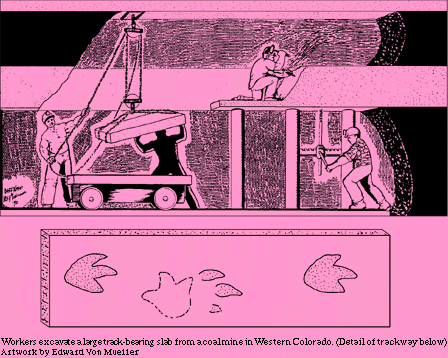 In the 1920s and 1930s the discovery of giant hadrosaur tracks in the Cretaceous coal mines of Colorado and Utah generated much excitement. Barnum Brown of the American Museum played down the obvious duck-bill affinity of the tracks1 and stressed their gigantic size, suggesting that no known track-maker was large enough to make such huge footprints. He dubbed the trackmaker the Mystery Dinosaur and claimed that it was capable of covering 15 feet (almost 5 meters) in a single step (see diagram). To support this claim he mounted a major excavation from a coal mine in Cedaredge, Colorado, to remove two large tracks that he claimed showed this monstrous 15-foot step. Although it was later demonstrated that this "step" was in fact a stride of two consecutive steps of 7 1/2 feet, speculation about the giant mystery trackmaker remained rife. Brown's emphasis on giant tracks and giant steps fostered a Guinness Book of Records attitude toward footprints. People were eager to claim record-breaking statistics, and soon a step of 16 feet 3 inches was reported.2 If this was not phenomenal enough, the same author had earlier reported a site where a dinosaur had stepped on an animal resembling a crocodile. Unfortunately no other information was given.3 Although it is theoretically possible that a dinosaur could have stepped on a live crocodile, or one that was already dead, the account lacks scientific substance and must reside in the files under the heading Crushed Crocodile Myth. For those interested in unusual paleontological phenomena, there is an example of a fossil flamingo that was stepped on by a camel during the Tertiary period.4 _______________
|